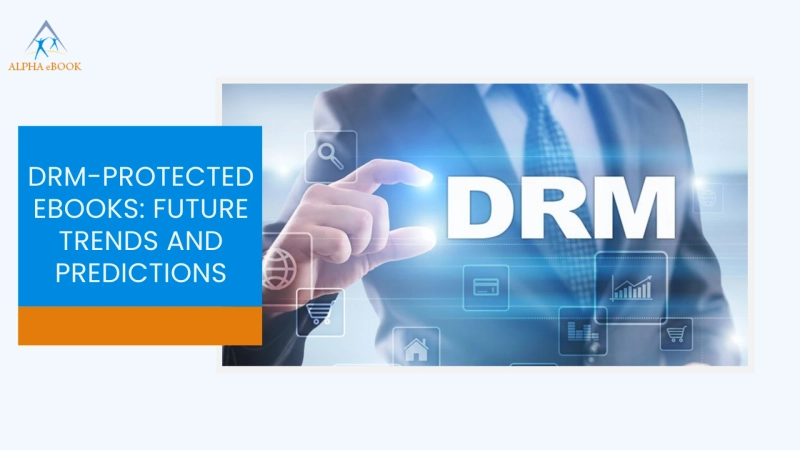The advancements and innovations in the digital transformation and online publishing have revolutionized the way we consume content and literature for a better reading experience. However, with books now accessible instantly through various digital platforms, ebooks have undergone a dramatic evolution to boost efficiency.
In this shift, DRM protected ebooks have become a central topic in the online publishing industry, sparking discussions about security, accessibility, and the delicate balance between user rights and publisher protections.
As technology innovates and the demand for digital books grows, understanding the significance of ebook conversion and the area where DRM is approaching is crucial for both creators and readers. This article discusses the emerging trends and predictions of DRM-protected ebooks.
Crucial Reasons Why DRM Matters In Digital Publishing
Digital rights management, or in simple terms, DRM, refers to advanced, innovative technology created to control access to digital content. DRM is a powerful tool for safeguarding digital works from piracy, duplication, preventing unauthorized copying, and ensuring regulatory compliance with copyright laws in the overall digital publishing era.
The digital rights management protects intellectual property for authors and publishers, but for readers, it helps them maintain the value and credibility of the content they purchase. While buying a physical book provides complete ownership, purchasing an ebook offers a license to read, unlike full ownership. This difference will raise questions about content access control and user rights, which will revolutionize the future of the online publishing system.
Present Difficulties and Challenges In DRM Protection
DRM has its challenges and difficulties apart from its advantages. The global readers sometimes feel that DRM protection restricts their reading experiences, particularly when they want to switch between digital platforms or share content across devices.
In addition, tech-savvy users have developed techniques to bypass DRM after converting a physical book to ebook, creating an ongoing battle between execution and overcoming a problem.
The publishing industry experiences the challenge of designing DRM systems that protect content without isolating audiences. Publishers need to focus on improving user experience while still restricting access to unauthorized users. This artistic balance will clearly define the success of future DRM models:
Emerging Trends Transforming The Future Of DRM Protected eBooks
Sophisticated Blockchain Technology For Readership and Ownership Verification
Modern blockchain technology is an emerging trend and a contemporary solution for handling digital content rights. By recording every eBook purchase securely in a decentralized ledger, modern blockchain technology could allow readers to prove their rights and ownership of the eBook content. This proactive approach could solve significant concerns regarding long-term access and resale rights for ebooks.
User Centric Digital Rights Management Models
Future DRM systems will concentrate more on user experience and convenience. Compared to restricting content to a single device or application, both publishers and authors adopt flexible content models that allow reading content across different digital platforms without compromising DRM protection rules.
It involves sharing for a limited time or cloud-based libraries that allow instant access from anywhere, while limiting instant access to irrelevant users.
Advanced AI-Powered DRM Solutions
One of the most promising innovations is the integration of AI into advanced DRM systems. The AI can boost security by determining unusual download or reading patterns, showcasing breaches in content access control.
It can help predict and respond to piracy trends in real-time, making digital rights management more adaptive. The combined AI-based DRM creates smarter verification tasks that work effectively in the system background, which enhances the reading experience without requiring user intervention.
Cloud-Based DRM Systems
Cloud-based DRM solutions will achieve higher popularity because of their ease of use and greater scalability. With cloud-based digital publishing platforms, DRM systems receive continuous updates, ensuring that digital rights management keeps pace with emerging piracy methods.
In addition, cloud storage services make it easy f or users to restore content, such as a well-structured ebook created using an ebook formatting service, if their device is lost or damaged, improving trust in the publishing industry.
Stronger Compliance With Global Copyright Laws
As digital content in the form of an ebook becomes accessible, several copyright laws will continue to evolve. Authors and publishers will require DRM systems that adjust to different regional regulations, ensuring that secure DRM protected ebooks remain compliant across markets.
It involves a complete automated system that provides rapid access to ebooks by transitioning from a physical book to an ebook based on the reader’s location, licensing terms, or language.
Forecasts For The Next Decade
The near future of digital rights management in online content publishing will bring various innovative things, like:
- Personalized Content Recommendations: AI can customize reading experiences based on user habits, offering content preferences and an intuitive reading environment without sacrificing DRM protection.
- Greater Integration Across Platforms: Customizable DRM solutions will need to work seamlessly on e-readers, smartphones, tablets, and web browsers, ensuring a consistent experience.
- Hybrid Access Models: Subscription-based services may provide DRM-enabled rentals alongside purchase options, giving readers more flexibility while protecting digital works.
- Sustainability Initiatives: With digital formats of ebooks created using a reliable ebook formatting service that reduces paper use, DRM will play a role in promoting environmentally friendly publishing platforms.
- Increased Transparency: Publishers will need to effectively communicate DRM policies more clearly, helping users understand the rights and limits of their purchases.
Balancing Protection And User Freedom
The tension between protecting content and offering freedom of use will continue to increase innovation in DRM. The future evolving systems will be those that safeguard the intellectual content without restrictions on the reader.
This process means including functions like device synchronization, offline file access, and resale rights within the DRM frameworks. Advanced technology service providers, publishers, and authors should identify that strict DRM measures can affect customer loyalty.
In contrast, higher tolerance risks losing control over content distribution. Making the right balance will be key to keeping both audiences and readers satisfied.
The Crucial Role Of The Publishing Industry In Transforming The Future Of DRM
The online publishing industry is crucial for shaping the future of DRM. Collaboration between authors, publishers, and technology companies will be necessary for developing secure and user-friendly DRM standards.
Industry-wide secure agreements on access control and DRM protection offer a more proactive approach to protecting digital content. By using advanced AI, blockchain, or online cloud-based digital publishing platforms, the industry will decide how DRM protected ebooks are identified in the future.
Get Secure Digital Content for Readers with DRM Protected eBooks by Using eBook Conversion Services
The future of DRM is about avoiding unauthorized copying, developing trust, delivering quality reading experiences, and allowing readers and authors to benefit from the digital age.
Digital rights management will need to keep pace with technological advancements by becoming smart and user-focused. The complete difficulty of implementing DRM in various ways for authors and publishers will encourage readers to read the content while protecting digital content. For readers, the goal is to appreciate the benefits of digital books without irrelevant limitations.
When more people make the transition from book to ebook, the coming years will likely see the DRM transformed from a limiting force into a supportive one, empowering the publishing industry to grow by giving readers more freedom than ever before.



